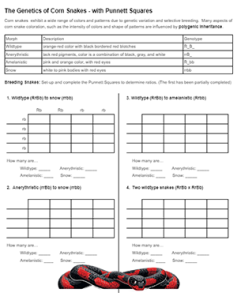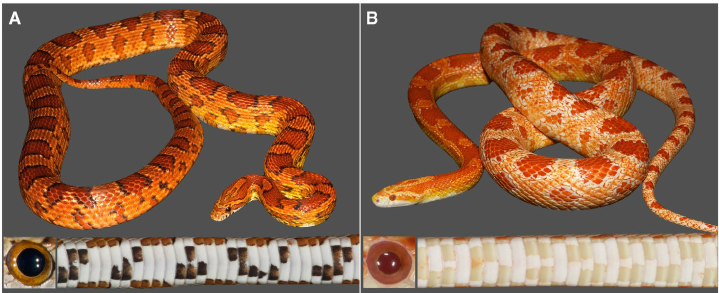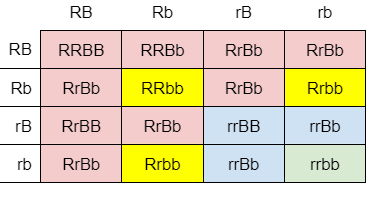
I have a corn snake in my classroom named Crawly. I consider him a snake ambassador because he is friendly, and not large and intimidating. Many students overcome their fear of snakes with Crawly. Some call him an “emotional support snake!”
So, Crawly is a great way to introduce dihybrid crosses. Many beginning students struggle with this topic, and could definitely use a little emotional support. I teach 2-trait crosses in both freshman biology and advanced (AP) biology. With freshman, they learn to do 4×4 squares, but with my older students, they learn to use the multiplicative property.
In this activity, students review the genetics of corn snakes. I include a simplified version, mainly because there are so many different types, or morphs of corn snakes. Crawly is a amelanistic morph, also known as “candy-cane” due to his bright pink and orange colors.
The (Simplified) Genetics of Corn Snake Colors
Two main colors are responsible for the variety of corn snakes: red and black. The normal coloration, also known as wildtype, is orange with black markings. Wildtype snakes also have black eyes.
Another set of genes (R) deals with red pigmentation. The genetics behind the inheritance of color can be viewed as whether or not a snake has both red and black- as in the normal corn, only red as in the amelanistic (like Crawly) or only black as in the anerythristic. A snake that has neither black or red results in the “snow” coloration, which is mostly white.

Combining these sets of genes in crosses determine whether the offspring will be wildtype, amelanistic, anerythristic, or snow.
R_B_ = Wildtype
rrB_ = Anerythristic
R_bb = Amelanistic (Crawly!)
rrbb = Snow
Student Practice
There are two versions of the worksheet. In the first version, students use the multiplicative property to solve crosses. This is something my advanced (AP) biology students learn. Instead of making the large 4×4 crosses, which is time consuming, and prone to error, students use simple math to solve the problems. For example in a dihybrid cross – AaBb x AaBb – 3/4 will display the dominant A allele, 3/4 will display the dominant B allele. Therefore, 9/16 will display both dominant traits.
If you do the math for all the combinations, you will find the well-known 9:3:3:1 ratio of Mendel’s dihybrid crosses.
In the other version, students complete Punnett squares. I find this to be better for my basic biology students. There are not as many crosses to complete on this worksheet, because it does take a long time to complete the squares.
In the answer key, I color code the phenotypes to make it easier to see the ratios.

This type of cross does make things a little more complicated than a basic Mendel cross, like Round, Tall x Wrinkled, Short (RrTt x RrTt) because with the snakes, the phenotypes all relate to color. If you want a more basic cross, try the bunny genetics worksheet.

